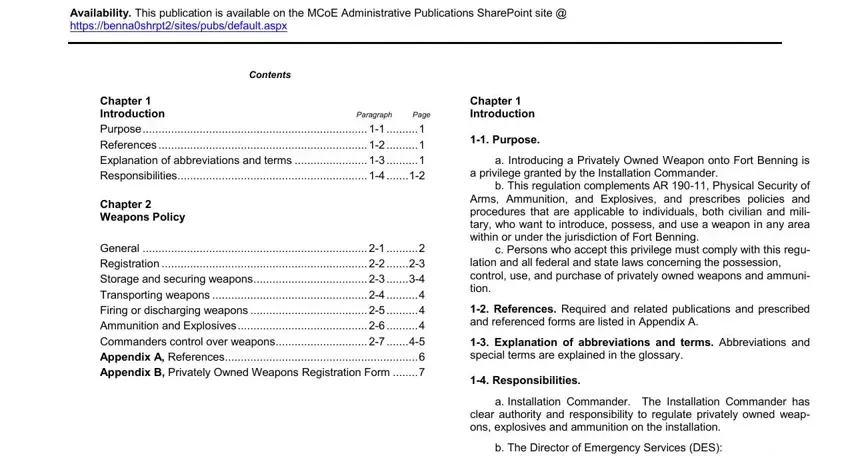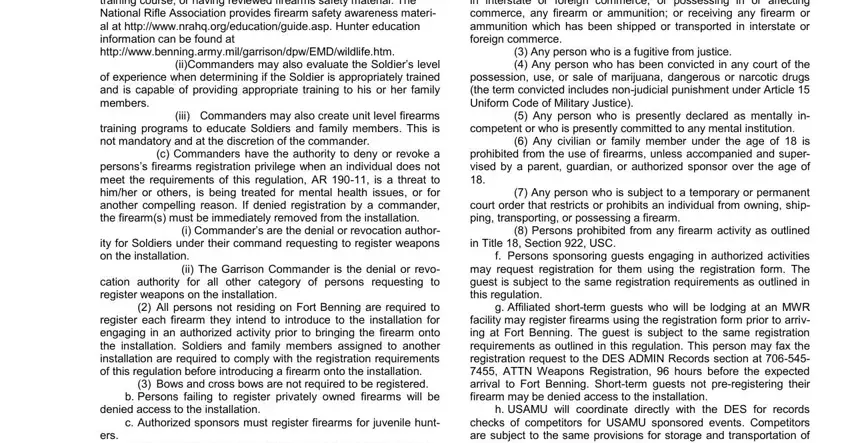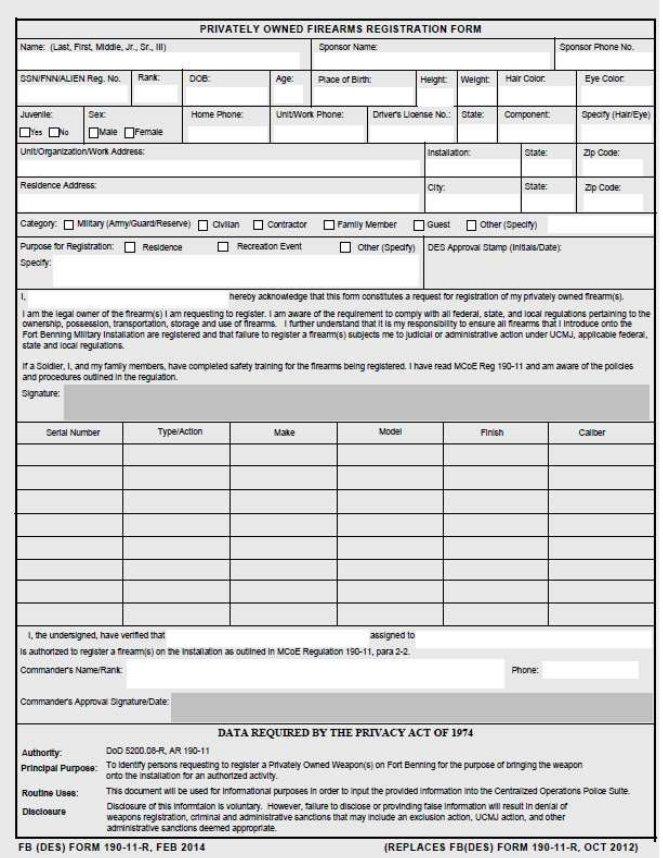Benning, the person must submit an updated registration form, with only the new firearm information, before the firearm is used for any
recreational activity. Soldiers registering new firearms must obtain their commander’s approval and signature on the registration form.
k. Persons can report to the Military Police Station ADMIN Rec- ords section during normal duty hours to request removal of a weapon(s) from the COPS system upon presenting proper identifica- tion.
2-3. Storage and Securing Firearms.
a. General. Personnel storing privately owned firearms and ammunition (including authorized war trophy firearms) on an installa- tion will—
(1)Comply with federal, state, and local laws and regulations on ownership, possession, registration, off-post transport, and use.
(2)Store both firearms and ammunition in the unit arms room or other locations authorized by the installation commander.
(3)Follow local security and safety regulations.
(4)Safeguard the unit issued DA Form 3749, Equipment Re- ceipt, for turn-in to the unit armorer when the firearm is withdrawn from the arms room.
(5)Withdraw privately owned firearms and ammunition from the unit arms rooms only upon approval of the unit commander or authorized representative.
(6)Comply with the National Firearms Act and other relevant laws and regulations when receiving or bringing arms into the United States.
b.Storing Firearms.
(1)Privately owned firearms can only be stored at authorized locations. These locations are unit arms rooms, on post quarters, MWR lodging facilities, MWR range facilities, or other facilities ap- proved by the DES Physical Security Branch. Storage of firearms in privately-owned vehicles is prohibited.
(2)Military personnel and family members residing in on post housing may store firearms and privately owned weapons and am- munition in their quarters.
(a)Firearm(s) will be secured in either a locked contain- er or with an affixed trigger lock.
(b)Ammunition for the firearm will be secured separately from the firearm in a locked container that prevents opening by juve- nile family members.
(3)Military personnel who reside on post in other than family housing (in barracks or bachelor officer quarters, for example) must store privately owned firearms, explosives, and ammunition in the arms room of their immediate organizational commander in accord- ance with AR 190-11, Physical Security of Arms, Ammunition, and Explosives.
(4)Persons residing at an MWR lodging facility, and who have registered their firearm(s), are required to store their firearm(s) outlined in paragraph 2-3.b.(1)(a) and (b) above.
c.Temporarily securing firearms in vehicles. Firearms may be temporarily secured in vehicles while an individual is stopped at a location associated with an authorized activity. These temporary stops allow authorized individuals to pick up or drop off others partic- ipating in the activity, to purchase items that support the activity, to fulfill installation directed requirements, or to perform commander designated mission essential duties (Examples include, AAFES shoppettes, gas stations, eateries, government quarters, Uchee Creek Recreation Area, deer check/cleaning stations, etc.). Fire- arms must be secured IAW Paragraph 2-4 during temporary stops.
d. Persons residing off the installation may transport a firearm on or off the installation for later off post use. Prior to introducing the firearm onto the installation, the firearm must be registered with the MP Station. The firearm must be cased, with ammunition separated from the firearm, and transported as outlined in paragraph 2-4 below. The firearm can only be stored at a location outlined in paragraph 2-
3.b. (1) above.
2-4. Transporting of Firearms.
Personnel may transport authorized weapons on or off post for hunt- ing, sports shooting, or other legitimate reasons, to include recognized functions or activities involving a firearm.
a. When transporting firearms, personnel will ensure:
MCoE Regulation 190-11
(1)The firearm(s) is unloaded and separated from the am- munition. The term “separated” means that the ammunition is not attached or affixed to the firearm and is not stored inside the case with the firearm. Ammunition may be stored in a pocket or compart- ment on the outside of the case.
(2)Muzzle loading firearms may contain a powder charge and projectile in the chamber but cannot have a percussion cap, primer, flint, powder or other firing device on the nipple or flash pan. Electronic ignition muzzle loading firearms must have the battery removed and separated from the firearm.
(3)All firearms will be transported in a gun case, secured and not in plain view from outside the vehicle. If the vehicle has a trunk the firearm must be transported in the trunk. Regardless of whether the vehicle has a trunk or not, the firearm must be placed in a hard or soft case with the ammunition separated from the firearm.
Firearms in a "gun sock" or holster will not be considered cased. The actual firearm cannot be in “plain view.” Therefore, a firearm en-
closed in a standard hard or soft case is NOT in "plain view." At no time should a firearm, cased or un-cased, be transported in window gun racks. Under no circumstances may an uncased firearm be transported under or behind a seat or in a glove compartment, con- sole, seat pouch or similar location.
(4)Hunters travelling within a hunting area they are signed into do not have to re-case their firearm before transport. However, the firearm must be unloaded, the magazine removed from the fire- arm, and ammunition separated from the firearm.
(5)Personally owned firearms removed from the installation are done so in accordance with applicable Federal, state, and local laws pertaining to ownership, possession, and registration.
b. Crossbows cannot be cocked or have a bolt in the firing posi-
tion.
2-5. Firing or Discharging of Weapons.
Personnel may not:
a. Discharge a firearm or projectile weapon in the cantonment area and inside or adjacent to housing areas unless otherwise au- thorized by special permit in approved areas. All personnel must have appropriate documentation authorizing such activities. Military personnel may discharge weapons using blank ammunition in the cantonment area while practicing for funeral details or other special events.
b. Conduct target practice except on an authorized range. Con- tact Outdoor Recreation (706-545-7978) for information about target practice and firearms zeroing opportunities.
c. Discharge a firearm after legal hunting hours unless other- wise authorized by special permit or to remove a round from a muzzle loading firearm at the end of a hunt. Hunters who discharge a muzzle loading firearm after legal hours to remove a round must do so in the training area they were checked in to hunt that evening.
d. Discharge a firearm or projectile weapon from a vehicle or across a maintained road.
e. Discharge a firearm or projectile weapon within 200 feet of maintained roads, buildings, construction projects, or other man- made infrastructure.
f.Discharge a firearm or projectile weapon within 200 yards in the direction of a maintained road, buildings, construction projects, or other man-made infrastructure. A maintained road is a road with a base consisting of pavement, concrete, gravel, or improved dirt that receives maintenance and is wide enough to allow at least two-way vehicular traffic.
g.Paintball guns may only be fired on approved MWR sites or under command directed activities (e.g. training events, law en- forcement missions, etc.).
2-6. Ammunition and Explosives.
a. The unusual amount and diversified character of firing con- ducted on Fort Benning requires that special and intelligent care be exercised to avoid accidents. All concerned with handling, care and use of ammunition and explosives, or with the conduct or direction of any firing, or the care and police of buildings and areas which are used for storing explosives will familiarize themselves with current safety regulations and field and technical manuals pertaining to the munitions being handled.






